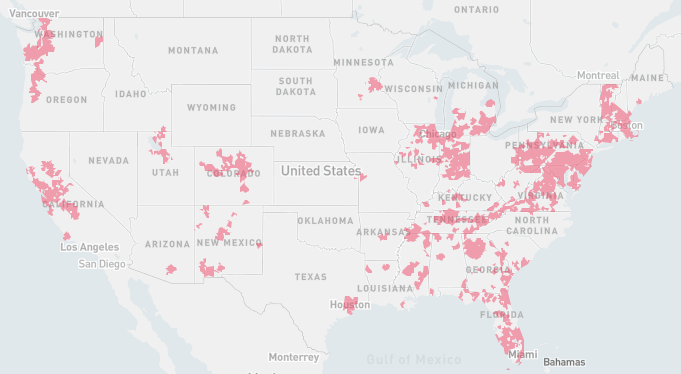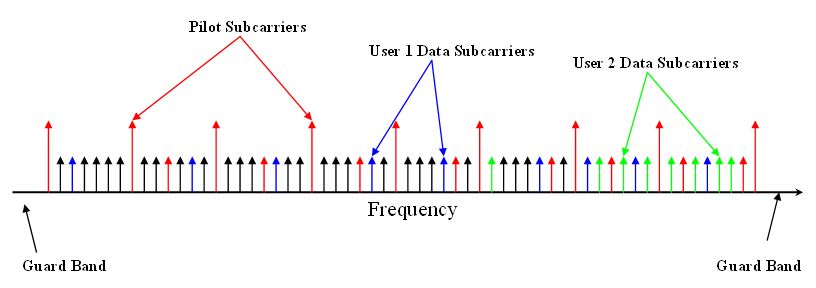|
DOCSIS
Data Over Cable Service Interface Specification (DOCSIS) is an international telecommunications standard that permits the addition of high-bandwidth data transfer to an existing cable television (CATV) system. It is used by many cable television operators to provide cable Internet access over their existing hybrid fiber-coaxial (HFC) infrastructure. History DOCSIS was originally developed by CableLabs and contributing companies, including Arris, BigBand Networks, Broadcom, Cisco, Comcast, Conexant, Correlant, Cox, Harmonic, Intel, Motorola, Netgear, Terayon, Time Warner Cable, and Texas Instruments. Versions ; : Released in March 1997, DOCSIS 1.0 included functional elements from preceding proprietary cable modems. ; : Released in April 1999, DOCSIS 1.1 standardized quality of service (QoS) mechanisms that were outlined in DOCSIS 1.0. ; (abbreviated D2) : Released in December 2001, DOCSIS 2.0 enhanced upstream data rates in response to increased demand for symmetric s ... [...More Info...] [...Related Items...] OR: [Wikipedia] [Google] [Baidu] |
Cable Modem
A cable modem is a type of network bridge that provides bi-directional data communication via radio frequency channels on a hybrid fibre-coaxial (HFC), radio frequency over glass (RFoG) and coaxial cable infrastructure. Cable modems are primarily used to deliver broadband Internet access in the form of cable Internet, taking advantage of the high bandwidth of a HFC and RFoG network. They are commonly deployed in the Americas, Asia, Australia, and Europe. History MITRE Cablenet Internet Experiment Note (IEN) 96IEN 96 - The Cablenet Project (1979) describes an early RF cable modem system. From pages 2 and 3 of IEN 96: The ... |
Link Aggregation
In computer networking, link aggregation is the combining ( aggregating) of multiple network connections in parallel by any of several methods, in order to increase throughput beyond what a single connection could sustain, to provide redundancy in case one of the links should fail, or both. A link aggregation group (LAG) is the combined collection of physical ports. Other umbrella terms used to describe the concept include trunking, bundling, bonding, channeling or teaming. Implementation may follow vendor-independent standards such as Link Aggregation Control Protocol (LACP) for Ethernet, defined in IEEE 802.1AX or the previous IEEE 802.3ad, but also proprietary protocols. Motivation Link aggregation increases the bandwidth and resilience of Ethernet connections. Bandwidth requirements do not scale linearly. Ethernet bandwidths historically have increased tenfold each generation: 10 megabit/s, 100 Mbit/s, 1000 Mbit/s, 10,000 Mbit/s. If one started to bump in ... [...More Info...] [...Related Items...] OR: [Wikipedia] [Google] [Baidu] |
Cable Television
Cable television is a system of delivering television programming to consumers via radio frequency (RF) signals transmitted through coaxial cables, or in more recent systems, light pulses through fibre-optic cables. This contrasts with broadcast television (also known as terrestrial television), in which the television signal is transmitted over-the-air by radio waves and received by a television antenna attached to the television; or satellite television, in which the television signal is transmitted over-the-air by radio waves from a communications satellite orbiting the Earth, and received by a satellite dish antenna on the roof. FM radio programming, high-speed Internet, telephone services, and similar non-television services may also be provided through these cables. Analog television was standard in the 20th century, but since the 2000s, cable systems have been upgraded to digital cable operation. A "cable channel" (sometimes known as a "cable network") is a tele ... [...More Info...] [...Related Items...] OR: [Wikipedia] [Google] [Baidu] |
Hybrid Fiber-coaxial
Hybrid fiber-coaxial (HFC) is a telecommunications industry term for a broadband network that combines optical fiber and coaxial cable. It has been commonly employed globally by cable television operators since the early 1990s. In a hybrid fiber-coaxial cable system, the television channels are sent from the cable system's distribution facility, the headend, to local communities through optical fiber subscriber lines. At the local community, a box called an optical node translates the signal from a light beam to radio frequency (RF), and sends it over coaxial cable lines for distribution to subscriber residences. The fiberoptic trunk lines provide adequate bandwidth to allow future expansion and new bandwidth-intensive services such as internet access through DOCSIS. Description The fiber optic network extends from the cable operators' master headend, sometimes to regional headends, and out to a neighborhood's hubsite, and finally to a coaxial cable node which serves anyw ... [...More Info...] [...Related Items...] OR: [Wikipedia] [Google] [Baidu] |
CableLabs
Cable Television Laboratories, Inc. (CableLabs) is a nonprofit corporation promoting innovation as a research and development lab founded in 1988 by American cable operators. System operators from around the world are eligible to be members. The DOCSIS standard for cable Internet access was originally developed by CableLabs and contributing companies, including Arris, BigBand Networks, Broadcom, Cisco, Comcast, Conexant, Correlant, Cox, Harmonic, Intel, Motorola, Netgear, Terayon, Time Warner Cable, and Texas Instruments Texas Instruments Incorporated (TI) is an American technology company headquartered in Dallas, Texas, that designs and manufactures semiconductors and various integrated circuits, which it sells to electronics designers and manufacturers globall .... See also * References External links * CableLabs Specifications Database {{Authority control Boulder County, Colorado Cable television in the United States Intelligent Community Forum Non-profit ... [...More Info...] [...Related Items...] OR: [Wikipedia] [Google] [Baidu] |
Bufferbloat
Bufferbloat is a cause of high latency and jitter in packet-switched networks caused by excess buffering of packets. Bufferbloat can also cause packet delay variation (also known as jitter), as well as reduce the overall network throughput. When a router or switch is configured to use excessively large buffers, even very high-speed networks can become practically unusable for many interactive applications like voice over IP (VoIP), audio streaming, online gaming, and even ordinary web browsing. Some communications equipment manufacturers designed unnecessarily large buffers into some of their network products. In such equipment, bufferbloat occurs when a network link becomes congested, causing packets to become queued for long periods in these oversized buffers. In a first-in first-out queuing system, overly large buffers result in longer queues and higher latency, and do not improve network throughput. It can also be induced by specific slow-speed connections hindering ... [...More Info...] [...Related Items...] OR: [Wikipedia] [Google] [Baidu] |
Internet Protocol Version 6
Internet Protocol version 6 (IPv6) is the most recent version of the Internet Protocol (IP), the communications protocol that provides an identification and location system for computers on networks and routes traffic across the Internet. IPv6 was developed by the Internet Engineering Task Force (IETF) to deal with the long-anticipated problem of IPv4 address exhaustion, and is intended to replace IPv4. In December 1998, IPv6 became a Draft Standard for the IETF, which subsequently ratified it as an Internet Standard on 14 July 2017. Devices on the Internet are assigned a unique IP address for identification and location definition. With the rapid growth of the Internet after commercialization in the 1990s, it became evident that far more addresses would be needed to connect devices than the IPv4 address space had available. By 1998, the IETF had formalized the successor protocol. IPv6 uses 128-bit addresses, theoretically allowing 2128, or approximately total addresses. The ... [...More Info...] [...Related Items...] OR: [Wikipedia] [Google] [Baidu] |
Orthogonal Frequency-division Multiplexing
In telecommunications, orthogonal frequency-division multiplexing (OFDM) is a type of digital transmission and a method of encoding digital data on multiple carrier frequencies. OFDM has developed into a popular scheme for wideband digital communication, used in applications such as digital television and audio broadcasting, DSL internet access, wireless networks, power line networks, and 4G/ 5G mobile communications. OFDM is a frequency-division multiplexing (FDM) scheme that was introduced by Robert W. Chang of Bell Labs in 1966. In OFDM, multiple closely spaced orthogonal subcarrier signals with overlapping spectra are transmitted to carry data in parallel.webe.org - 2GHz BAS Relocation Tech-Fair, COFDM Technology Basics 2007-03-02 Demodula ... [...More Info...] [...Related Items...] OR: [Wikipedia] [Google] [Baidu] |
Xfinity
Comcast Cable Communications, LLC, doing business as Xfinity, is an American telecommunications company and division of Comcast Corporation used to market consumer cable television, internet, telephone, and wireless services provided by the company. The brand was first introduced in 2010; prior to that, these services were marketed primarily under the Comcast name. Its CEO is Dave Watson, its chairman is Brian L. Roberts, and its CFO is Catherine Avgiris. Xfinity went from $23.7 billion in revenue in 2007 to $50.04 billion in 2016. Branding In February 2010, Comcast began to re-brand its consumer triple play service offerings under the name Xfinity; Comcast Digital Cable was renamed "Xfinity TV", Comcast Digital Voice became "Xfinity Voice", and Comcast High Speed Internet became "Xfinity Internet". The re-branding and an associated promotional campaign were scheduled to coincide with the 2010 Winter Olympics. The rebranding was characterized by the media as an effort to side ... [...More Info...] [...Related Items...] OR: [Wikipedia] [Google] [Baidu] |
Cable Internet Access
In telecommunications, cable Internet access, shortened to cable Internet, is a form of broadband Internet access which uses the same infrastructure as a cable television. Like digital subscriber line and fiber to the premises services, cable Internet access provides network edge connectivity ( last mile access) from the Internet service provider to an end user. It is integrated into the cable television infrastructure analogously to DSL which uses the existing telephone network. Cable TV networks and telecommunications networks are the two predominant forms of residential Internet access. Recently, both have seen increased competition from fiber deployments, wireless, and mobile networks. Hardware and bit rates Broadband cable Internet access requires a cable modem at the customer's premises and a cable modem termination system (CMTS) at a cable operator facility, typically a cable television headend. The two are connected via coaxial cable or a hybrid fibre-coaxial (HFC) plant ... [...More Info...] [...Related Items...] OR: [Wikipedia] [Google] [Baidu] |
Light Reading
Light Reading Inc. is a telecommunications industry information company based in New York City. Its activities include publishing, data analysis, market research, and events management. History The company was founded in 2000 by Stephen Saunders and was bought by UBM for $33 million in 2005, becoming part of the UBM subsidiary CMP Media. Saunders remained as CEO and launched Internet Evolution later in 2005. Light Reading's market research arm, Heavy Reading, bought Pyramid Research in August 2008. Light Reading also had its India publication, Light Reading India. The site had been covering the Indian telecom ecosystem from 2011 till January 2015. It was shut down when UBI India stopped its operations. In August 2013, Light Reading migrated to UBM's DeusM community platform. In February 2014, Stephen Saunders reacquired Light Reading from UBM, with UBM retaining a "significant minority stake" in the company.{{cite web , url=http://www.foliomag.com/2009/stephen-saunders, title ... [...More Info...] [...Related Items...] OR: [Wikipedia] [Google] [Baidu] |
Subcarrier
A subcarrier is a sideband of a radio frequency carrier wave, which is modulated to send additional information. Examples include the provision of colour in a black and white television system or the provision of stereo in a monophonic radio broadcast. There is no physical difference between a carrier and a subcarrier; the "sub" implies that it has been derived from a carrier, which has been amplitude modulated by a steady signal and has a constant frequency relation to it. FM stereo Stereo broadcasting is made possible by using a subcarrier on FM radio stations, which takes the left channel and "subtracts" the right channel from it — essentially by hooking up the right-channel wires backward (reversing polarity) and then joining left and reversed-right. The result is modulated with suppressed carrier AM, more correctly called sum and difference modulation or SDM, at 38 kHz in the FM signal, which is joined at 2% modulation with the mono left+right audio (which ran ... [...More Info...] [...Related Items...] OR: [Wikipedia] [Google] [Baidu] |



